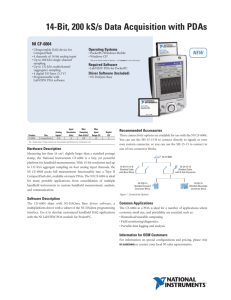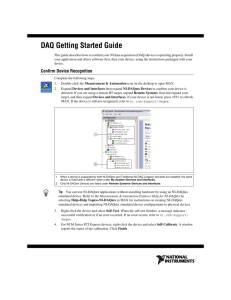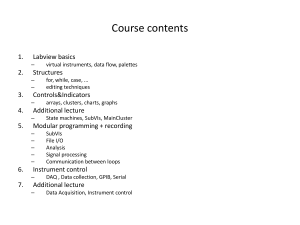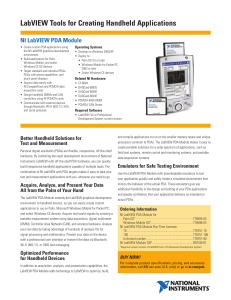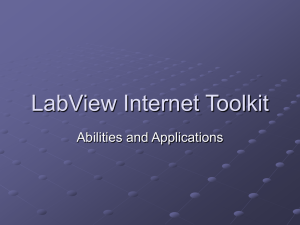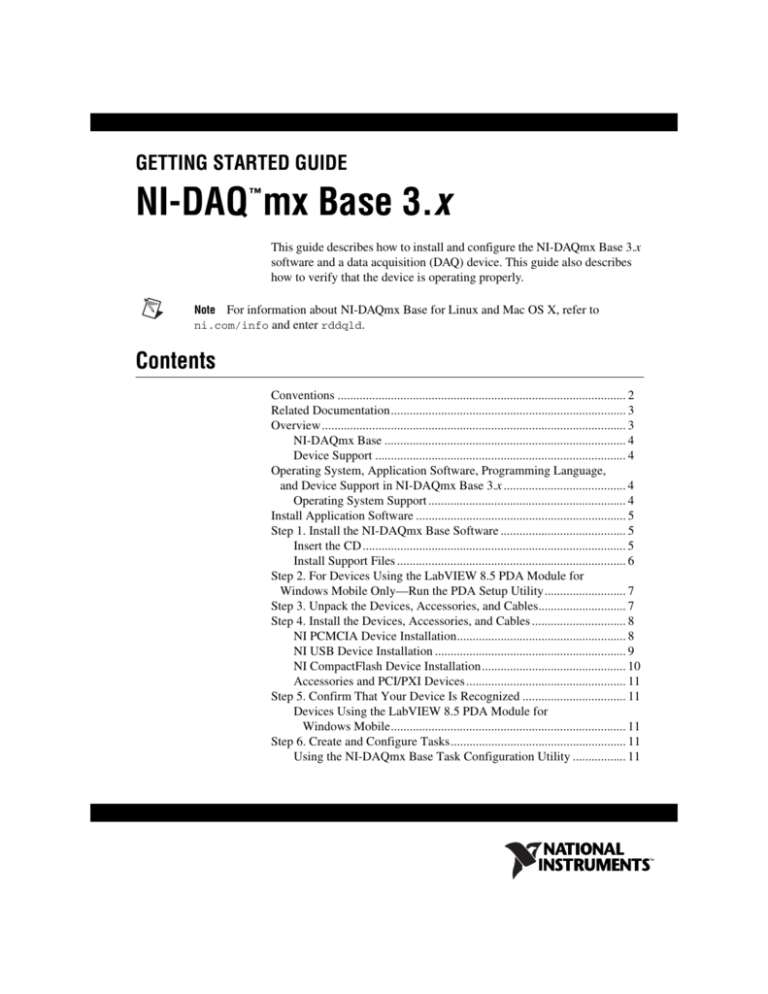
GETTING STARTED GUIDE
NI-DAQ mx Base 3.x
™
This guide describes how to install and configure the NI-DAQmx Base 3.x
software and a data acquisition (DAQ) device. This guide also describes
how to verify that the device is operating properly.
Note For information about NI-DAQmx Base for Linux and Mac OS X, refer to
ni.com/info and enter rddqld.
Contents
Conventions ............................................................................................ 2
Related Documentation........................................................................... 3
Overview ................................................................................................. 3
NI-DAQmx Base ............................................................................. 4
Device Support ................................................................................ 4
Operating System, Application Software, Programming Language,
and Device Support in NI-DAQmx Base 3.x ....................................... 4
Operating System Support ............................................................... 4
Install Application Software ................................................................... 5
Step 1. Install the NI-DAQmx Base Software ........................................ 5
Insert the CD .................................................................................... 5
Install Support Files ......................................................................... 6
Step 2. For Devices Using the LabVIEW 8.5 PDA Module for
Windows Mobile Only—Run the PDA Setup Utility.......................... 7
Step 3. Unpack the Devices, Accessories, and Cables............................ 7
Step 4. Install the Devices, Accessories, and Cables .............................. 8
NI PCMCIA Device Installation...................................................... 8
NI USB Device Installation ............................................................. 9
NI CompactFlash Device Installation.............................................. 10
Accessories and PCI/PXI Devices ................................................... 11
Step 5. Confirm That Your Device Is Recognized ................................. 11
Devices Using the LabVIEW 8.5 PDA Module for
Windows Mobile........................................................................... 11
Step 6. Create and Configure Tasks........................................................ 11
Using the NI-DAQmx Base Task Configuration Utility ................. 11
Devices Using the LabVIEW 8.5 PDA Module for
Windows Mobile ....................................................................12
Create, Modify, and Configure a Task in NI-DAQmx Base.....13
Devices Using the LabVIEW 8.5 PDA Module for
Windows Mobile ...........................................................................14
Using Tasks in an Application .........................................................15
Documentation.........................................................................................15
Getting Started Developing an Application.............................................15
Examples ..........................................................................................15
Devices on LabVIEW 8.5 PDA Module for
Windows Mobile ....................................................................16
Obtaining Information about Measurement Applications
and Devices....................................................................................16
LabVIEW ..................................................................................16
ANSI C......................................................................................16
Training Courses .......................................................................17
Where to Go for Support .........................................................................17
Conventions
The following conventions are used in this guide.
»
The » symbol leads you through nested menu items and dialog box options
to a final action. The sequence File»Page Setup»Options directs you to
pull down the File menu, select the Page Setup item, and select Options
from the last dialog box.
This icon denotes a tip, which alerts you to advisory information.
This icon denotes a note, which alerts you to important information.
This icon denotes a caution, which advises you of precautions to take
to avoid injury, data loss, or a system crash. When this symbol is marked
on the device, refer to the Read Me First: Safety and Radio-Frequency
Interference document, shipped with the device, for precautions to take.
bold
Bold text denotes items that you must select or click in the software, such
as menu items and dialog box options. Bold text also denotes parameter
names.
italic
Italic text denotes variables, emphasis, a cross-reference, or an introduction
to a key concept. Italic text also denotes text that is a placeholder for a word
or value that you must supply.
monospace
Text in this font denotes text or characters that you should enter from the
keyboard, sections of code, programming examples, and syntax examples.
This font is also used for the proper names of disk drives, paths, directories,
NI-DAQmx Base Getting Started Guide
2
ni.com
programs, subprograms, subroutines, device names, functions, operations,
variables, filenames, and extensions.
monospace italic
Italic text in this font denotes text that is a placeholder for a word or value
that you must supply.
Related Documentation
The following documents contain information you might find helpful as
you read this guide:
•
•
•
Software documentation
–
NI-DAQmx Base Help
–
NI-DAQmx Base C Function Reference Help
–
NI-DAQmx Base 3.x Readme
–
NI-DAQmx Help
–
Getting Started with the LabVIEW PDA Module for Windows
Mobile, available in PDF format by selecting Start»Programs»
National Instruments»LabVIEW 8.5»LabVIEW Manuals
and selecting PDA_Getting_Started.pdf
–
LabVIEW Help, available by selecting Help»Search the
LabVIEW Help
–
LabVIEW Fundamentals, available in PDF format by selecting
Start»Programs»National Instruments»LabVIEW 8.5»
LabVIEW Manuals and selecting LV_Fundamentals.pdf
Hardware documentation
–
CF-6004 User Guide
–
NI USB-6008/6009 User Guide and Specifications
–
NI USB-6501 User Guide and Specifications
–
E Series User Manual
Documentation for the PDA device you use
Overview
National Instruments measurement devices are packaged with NI-DAQmx
or NI-DAQmx Base driver software. NI-DAQmx includes an extensive
library of VIs and ANSI C functions that you can call from your application
software, such as LabVIEW or NI LabWindows™/CVI™, to program all the
features of your NI measurement devices. The NI-DAQmx Base driver
software has an application programming interface (API), which is a
library of VIs and ANSI C functions for creating applications for your
device.
© National Instruments Corporation
3
NI-DAQmx Base Getting Started Guide
NI-DAQmx Base
NI-DAQmx Base is a driver that allows you to build applications that
run using a PDA device and Windows. NI-DAQmx Base includes the
following features:
•
NI-DAQmx Base is a subset of the NI-DAQmx API and is similar in
functionality to NI-DAQmx.
•
NI-DAQmx Base consists of a LabVIEW VI framework, which allows
you to customize the driver, if needed, when using LabVIEW.
•
NI-DAQmx Base provides a high-level interface on the
LabVIEW 8.5 PDA Module for Windows Mobile,
Windows 2000/XP, and Windows Vista x86/x64.
Note If you are familiar with NI-DAQmx, refer to the NI-DAQmx Base 3.x Readme for
information about the differences between NI-DAQmx Base and NI-DAQmx.
Device Support
NI-DAQmx Base 3.x supports the following devices under the
LabVIEW 8.5 PDA Module for Windows Mobile:
•
NI CF-6004
•
NI DAQCard-6024E
•
NI DAQCard-6036E
•
NI DAQCard-6062E
•
NI USB-6008
•
NI USB-6009
•
NI USB-6501
Operating System, Application Software, Programming
Language, and Device Support in NI-DAQmx Base 3.x
Operating System Support
NI-DAQmx Base 3.x supports Windows 2000/XP and
Windows Vista x86/x64. The development environment for devices on
the LabVIEW 8.5 PDA Module for Windows Mobile is supported on
Windows 2000/XP and Windows Vista x86/x64.
Only one version of NI-DAQmx Base (such as NI-DAQmx Base 3.0) can be
installed on the same computer at the same time.
Note
NI-DAQmx Base Getting Started Guide
4
ni.com
Install Application Software
Install the NI application software, including LabVIEW,
NI LabWindows/CVI, and NI Measurement Studio. PDA Module users
must use LabVIEW 8.5 PDA Module for Windows Mobile with
NI-DAQmx Base 3.0. Refer to the Operating System, Application
Software, Programming Language, and Device Support
in NI-DAQmx Base 3.x section for more information. Also, refer to Getting
Started with the LabVIEW PDA Module for Windows Mobile for more
information by selecting Start»Programs»National Instruments»
LabVIEW 8.5»LabVIEW Manuals and selecting
PDA_Getting_Started.pdf.
PDA Module users should make sure that LabVIEW 8.5 PDA Module for Windows
Mobile is completely installed and configured before continuing.
Note
Step 1. Install the NI-DAQmx Base Software
The following sections describe how to install the NI-DAQmx Base
software.
Insert the CD
Install your driver software before installing new hardware devices, or the operating
system might not detect your device, and you might see warnings asking you to install the
driver.
Note
Inserting the CD launches the NI-DAQmx Base install window.
If the NI-DAQmx Base install window does not open automatically,
complete the following steps:
1.
Select Start»Run.
2.
Enter x:\setup.exe, where x is the letter of the CD drive.
3.
Click Install NI-DAQmx Base.
© National Instruments Corporation
5
NI-DAQmx Base Getting Started Guide
Install Support Files
The NI-DAQmx Base installer detects the NI software installed on the
operating system and automatically selects the latest versions of the driver,
application software, and language support files from the CD.
The NI-DAQmx Base installer displays which features will be installed on
your computer, as shown.
Complete the following steps to install NI-DAQmx Base.
1.
In the Features window, shown in the previous figure, verify that the
installer detected and selected the correct support files and the correct
version number of the application software.
2.
Click the + in front of the feature to expand the list of feature
subcomponents, as shown in the previous figure. You can select
additional options to install the support files, examples, and
documentation.
3.
Follow the software prompts.
4.
Click Finish and wait for the installer to complete. NI-DAQmx Base
might require you to reboot your computer to complete installation.
NI-DAQmx Base Getting Started Guide
6
ni.com
Step 2. For Devices Using the LabVIEW 8.5 PDA Module
for Windows Mobile Only—Run the PDA Setup Utility
After running the NI-DAQmx Base installation, you must copy the driver
files to the PDA device. Complete the following steps to run the Pocket PC
Driver Installation utility.
1.
Select Start»Programs»National Instruments»NI-DAQmx Base»
Utilities.
2.
Click Windows Mobile-CE Driver Installation. Clicking Windows
Mobile-CE Driver Installation launches the Pocket PC Add/Remove
Programs utility window.
3.
Click Yes in the Pocket PC Add/Remove Programs utility window to
install the device driver into the default application install directory.
4.
Check the PDA device screen to see if any additional steps are
requested, such as replacing an older driver.
If there are no error messages, you have successfully completed the steps
to install the driver files on the PDA device.
Step 3. Unpack the Devices, Accessories, and Cables
Your device ships in an antistatic package to prevent electrostatic discharge
(ESD) damage to the device. ESD can damage several components on
the device.
Caution
Never touch the exposed pins of connectors.
To avoid such damage, take the following precautions:
•
Ground yourself using a grounding strap or by touching a grounded
object.
•
Touch the antistatic package to a metal part of the computer chassis
before removing the device from the package.
Remove the device from the package and inspect the device for loose
components or any sign of damage. Notify NI if the device appears
damaged in any way. Do not install a damaged device in the computer,
PDA device, or PXI chassis.
Store the device in the antistatic package when the device is not in use.
For safety and compliance information, refer to the device documentation
packaged with your device.
© National Instruments Corporation
7
NI-DAQmx Base Getting Started Guide
Step 4. Install the Devices, Accessories, and Cables
NI PCMCIA Device Installation
Follow proper ESD precautions to ensure you are grounded before installing the
hardware.
Caution
The NI PCMCIA device supports hot insertion on a PDA device, which
means the NI PCMCIA device can be installed and removed without
rebooting the PDA device. You can install an NI PCMCIA device in any
available Type II PC Card slot.
1
4
DA
QC
ard
-60
62
5
2
6
®
7
3
1
2
3
PDA with Type II PC Card Slot
Type II PC Card Socket
PDA Expansion Pack
4
5
NI PCMCIA Device
I/O Cable
6
7
Accessory
I/O Signals
To install the NI PCMCIA device, refer to the preceding figure while
completing the following steps.
1.
Attach the Type II PC cardsleeve or expansion pack to the PDA device,
if necessary.
2.
NI PCMCIA devices have two connectors: a 68-pin PCMCIA bus
connector on one end and an I/O connector on the other end. The
NI PCMCIA device is keyed so that you can only insert it one way.
Insert the NI PCMCIA device in the slot until the connector is firmly
seated.
NI-DAQmx Base Getting Started Guide
8
ni.com
Caution Always grasp the cable by the connector you are inserting or removing.
Never pull directly on the I/O cable to unplug it from the PCMCIA device.
3.
Attach the I/O cable. Be careful not to put strain on the I/O cable when
inserting or removing the cable connector.
NI USB Device Installation
Follow proper ESD precautions to ensure you are grounded before installing the
hardware.
Caution
The NI USB devices support hot insertion on a PDA device, which means
you can install and remove the NI USB device without rebooting the PDA
device. You can install an NI USB device into any USB port that supports
USB host controller capabilities.
17
In
pu
ts
,1
4-
bi
t,
N
M IU
ul S
tif B
un ct 60
io 0
n 9
I/O
Di
gi
ta
l
32
8
1
An
a
lo
16
1
2
3
1
USB Cable
2
USB Adapter Cable
3
Synchronization Port
1.
Connect the USB adapter cable to the synchronization port on
the PDA.
2.
Connect the USB device to the adapter cable with the USB cable.
If you are using the USB device on a computer with Windows 2000/XP/Vista and
NI-DAQmx 7.5 or later installed on it, make sure the correct firmware is installed on the
device. Go to ni.com/info and enter code USBFirmware for more information.
Note
Note Before connecting a USB device to a PDA for the first time, you must connect the
USB device to a computer with NI-DAQmx Base 3.x installed on it in order to install the
appropriate firmware on the USB device. Go to ni.com/info and enter code
USBFirmware for more information.
© National Instruments Corporation
9
NI-DAQmx Base Getting Started Guide
NI CompactFlash Device Installation
Follow proper ESD precautions to ensure you are grounded before installing the
hardware.
Caution
The NI CompactFlash device supports hot insertion on a PDA device,
which means you can install and remove the NI CompactFlash device
without rebooting the PDA device. You can install an NI CompactFlash
device in any available Type II CompactFlash slot.
To install the NI CompactFlash device, refer to the following figure while
completing the following steps.
3
5
2
1
4
1
2
PDA with Type II CompactFlash Slot
NI CompactFlash Device
1.
3
4
I/O Cable
Accessory
5
I/O Signals
NI CompactFlash devices have two connectors: a 50-pin
CompactFlash bus connector on one end, and an I/O connector on the
other. The NI CompactFlash device is keyed so that you can insert it
only one way. Insert the NI CompactFlash device in the slot until the
connector is firmly seated.
Always grasp the device by the connectors you are inserting or removing.
Never pull directly on the I/O to unplug it from the NI CompactFlash device.
Caution
NI-DAQmx Base Getting Started Guide
10
ni.com
2.
Attach the I/O cable. Be careful not to put strain on the I/O cable when
inserting or removing the cable connector.
Accessories and PCI/PXI Devices
Install accessories and/or terminal blocks according to the instructions in
their user guides. Install PCI and PXI devices according to the instructions
included with your device.
Step 5. Confirm That Your Device Is Recognized
The following section discusses how to confirm that your device is
recognized.
Devices Using the LabVIEW 8.5 PDA Module for Windows Mobile
Windows Mobile devices only indicate whether a hardware installation
error occurred. If there are no error messages, you have successfully
installed the features and the device is recognized by the NI-DAQmx Base
driver. If you receive an Unknown Device error message, you have not
correctly installed NI-DAQmx Base on the PDA device. Refer to Step 1.
Install the NI-DAQmx Base Software for more information about how to
install the PDA features of the NI-DAQmx Base driver.
Step 6. Create and Configure Tasks
A task, an important concept for NI-DAQmx and NI-DAQmx Base, is
a collection of one or more channels with timing, triggering, and other
properties. Conceptually, a task represents a measurement or generation
you want to perform. You can set up and save all configuration information
in a task and use the task in an application.
Using the NI-DAQmx Base Task Configuration Utility
The following sections describe how to use the NI-DAQmx Base Task
Configuration Utility.
© National Instruments Corporation
11
NI-DAQmx Base Getting Started Guide
Devices Using the LabVIEW 8.5 PDA Module for
Windows Mobile
Using the NI-DAQmx Base Task Configuration Utility is required when
using devices with the LabVIEW 8.5 PDA Module for Windows Mobile.
In NI-DAQmx Base 3.0, task information is embedded in the built
application. Prior to building and downloading your VI to the PDA device,
you must configure and save the tasks you want to use.
To use the Task Configuration Utility, complete the following steps:
1.
Open LabVIEW.
2.
Select Tools»NI-DAQmx Base Task Configuration Utility.
You also can launch the Task Configuration Utility from Start»Programs»
National Instruments»NI-DAQmx Base.
Note
NI-DAQmx Base Getting Started Guide
12
ni.com
Create, Modify, and Configure a Task in
NI-DAQmx Base
Create a new task or modify an existing task in the Task Configuration
Utility task list. The pre-installed tasks are configured to work with the
examples without modifications. To modify an existing task, select it in
the task list. To create a new task, complete the following steps:
1.
Click Create New Task. The Create New Task.vi window opens.
2.
Enter a name for the new task.
3.
Select the device. For devices using the LabVIEW 8.5 PDA Module
for Windows Mobile, select the device that matches your installed
hardware.
4.
Select the acquisition type. Click OK when finished.
5.
Each acquisition type contains a set of tabbed dialog boxes for
configuring the task. Configure all options specific to your task.
© National Instruments Corporation
13
NI-DAQmx Base Getting Started Guide
Tip
You can view context help for the Task Configuration Utility by pressing <Ctrl-H>.
6.
Click Save & Exit when you are finished configuring your tasks.
The task configuration is automatically saved into LabVIEW global
variables. You do not need to explicitly save the configuration.
To transfer the task configuration to other computers, click Export
Configuration and save the tasks to a file. You then can use Import
Configuration to import the task configuration.
The Import Configuration and Export Configuration options operate on the entire set
of tasks shown in the Task Configuration Utility. Importing a configuration replaces any
existing tasks, including the predefined tasks for the example programs.
Note
Devices Using the LabVIEW 8.5 PDA Module for Windows Mobile
When you are using devices that use the LabVIEW 8.5 PDA Module for
Windows Mobile, the task configuration is built into the target application.
You cannot retrieve the task information after it is embedded in a built
application. Exporting the configuration allows you to preserve the task in
case of accidental deletion when using the Task Configuration Utility.
NI-DAQmx Base Getting Started Guide
14
ni.com
Using Tasks in an Application
To use a preconfigured task in your application, complete the following
steps:
1.
Right-click the task/channels in terminal on a NI-DAQmx Base VI.
2.
Select Create»Control or Create»Constant.
3.
Type the name of the task in the control or constant.
4.
To set the value as the default for the control, right-click the control and
select Data Operations»Make Current Value Default.
Documentation
The NI-DAQmx Base software kit includes online documentation for
supported devices and accessories, including PDF and help files describing
device terminals, specifications, features, and operation.
After installation, the documents are accessible from Start»Programs»
National Instruments»NI-DAQmx Base»Documentation.
You must have Internet Explorer version 5.0 or later to use some features of the
NI-DAQmx Base documentation, including the help system.
Note
Getting Started Developing an Application
Examples
Each API includes a collection of programming examples to help you start
developing an application. You can modify example code and save it in an
application. You can use examples to develop a new application or add
example code to an existing application. NI-DAQmx Base examples
are accessible from Start»Programs»National Instruments»
NI-DAQmx Base»Examples.
© National Instruments Corporation
15
NI-DAQmx Base Getting Started Guide
The following figure illustrates a typical NI-DAQmx Base application in
LabVIEW. The pictured task uses a preconfigured task to acquire and
display a finite number of points for multiple channels.
Devices on LabVIEW 8.5 PDA Module for Windows
Mobile
Refer to Getting Started with the LabVIEW PDA Module for Windows
Mobile for more information about how to create a PDA application.
Obtaining Information about Measurement Applications and Devices
Each application software package and driver includes information about
writing applications for taking measurements and controlling measurement
devices. The following references assume you have NI-DAQmx Base and,
where applicable, LabVIEW installed on your computer.
LabVIEW
If you are a new user, complete Getting Started with LabVIEW to
get acquainted with LabVIEW. Select Start»Programs»National
Instruments»LabVIEW»LabVIEW Manuals and open
LV_Getting_Started.pdf.
The LabVIEW NI-DAQmx Base Help describes the LabVIEW VIs and
properties. In LabVIEW, select Help»Search the LabVIEW Help and the
VI reference help section for NI-DAQmx Base.
ANSI C
The NI-DAQmx Base C Function Reference Help contains an API
overview. Select Start»Programs»National Instruments»
NI-DAQmx Base C Function Reference Help.
NI-DAQmx Base Getting Started Guide
16
ni.com
Training Courses
National Instruments offers training courses for those interested in
receiving more help developing an application with NI products. To enroll
in a course or obtain a detailed course outline, refer to ni.com/training.
Where to Go for Support
The National Instruments Web site is your complete resource for technical
support. At ni.com/support you have access to everything from
troubleshooting and application development self-help resources to email
and phone assistance from NI Application Engineers.
National Instruments corporate headquarters is located at
11500 North Mopac Expressway, Austin, Texas, 78759-3504.
National Instruments also has offices located around the world to help
address your support needs. For telephone support in the United States,
create your service request at ni.com/support and follow the calling
instructions or dial 512 795 8248. For telephone support outside the United
States, contact your local branch office:
Australia 1800 300 800, Austria 43 662 457990-0,
Belgium 32 (0) 2 757 0020, Brazil 55 11 3262 3599,
Canada 800 433 3488, China 86 21 5050 9800,
Czech Republic 420 224 235 774, Denmark 45 45 76 26 00,
Finland 385 (0) 9 725 72511, France 01 57 66 24 24,
Germany 49 89 7413130, India 91 80 41190000, Israel 972 3 6393737,
Italy 39 02 413091, Japan 81 3 5472 2970, Korea 82 02 3451 3400,
Lebanon 961 (0) 1 33 28 28, Malaysia 1800 887710,
Mexico 01 800 010 0793, Netherlands 31 (0) 348 433 466,
New Zealand 0800 553 322, Norway 47 (0) 66 90 76 60,
Poland 48 22 3390150, Portugal 351 210 311 210, Russia 7 495 783 6851,
Singapore 1800 226 5886, Slovenia 386 3 425 42 00,
South Africa 27 0 11 805 8197, Spain 34 91 640 0085,
Sweden 46 (0) 8 587 895 00, Switzerland 41 56 2005151,
Taiwan 886 02 2377 2222, Thailand 662 278 6777,
Turkey 90 212 279 3031, United Kingdom 44 (0) 1635 523545
© National Instruments Corporation
17
NI-DAQmx Base Getting Started Guide
National Instruments, NI, ni.com, and LabVIEW are trademarks of National Instruments Corporation.
Refer to the Terms of Use section on ni.com/legal for more information about National
Instruments trademarks. Other product and company names mentioned herein are trademarks or trade
names of their respective companies. For patents covering National Instruments products, refer to the
appropriate location: Help»Patents in your software, the patents.txt file on your CD, or
ni.com/patents.
© 2004–2007 National Instruments Corporation. All rights reserved.
371259F-01
Jun07

